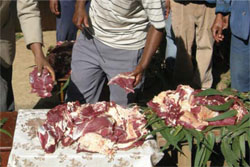38.2 Taeniasis (tapeworm infestation)
In this section, you will learn about the definition, mode of transmission, clinical manifestations, and methods of prevention of taeniasis (tapeworm infestation). Taeniasis is a parasitic zoonotic disease caused by the adult stage of large tapeworms that live in the intestines of human hosts. The most common causative agent in Ethiopia is the beef tapeworm, Taenia saginata, which has the cow as its intermediate host. The other tapeworm that can cause taeniasis (Taenia solium) has pigs as its intermediate host, but they are not so common in Ethiopia. Taeniasis due to beef tapeworm is highly prevalent in Ethiopia due to the widespread habit of eating raw beef (kitfo in Amharic, Figure 38.5) and poor sanitary conditions. Defaecation in open fields in grazing lands, disposal of raw human sewage in rivers and its use as a fertiliser, facilitate the spread of taeniasis. The highest cases of taeniasis are found in the towns of Northern and Eastern Ethiopia.

Other tapeworm diseases also exist in certain communities, e.g. people in fishing communities may be exposed to fish tapeworms (Diphyllobothrium species). Hydatid disease is also found in some parts of Ethiopia, caused by Ecchinococcus tapeworms transmitted mainly by dogs, which also infect people, cattle, sheep and horses. However, in this study session, we are focusing exclusively on the most prevalent form of tapeworm infestation in Ethiopia – taeniasis transmitted to humans by cows.
38.1.4 Prevention of rabies
